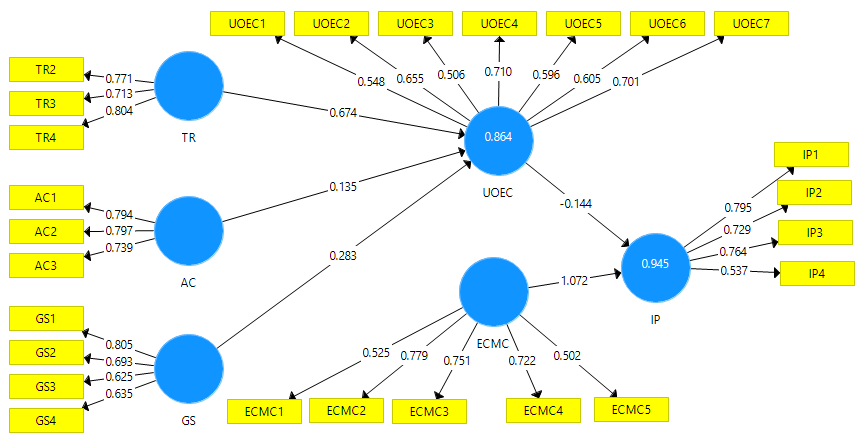Interfering Factors of Use of E-Commerce Toward Innovative Performance of SMEs by Moderating The Effects of E-commerce Marketing Capabilities
Keywords:
Use of E-commerce, Innovative Performance of SMEs, E-commerce marketing Capabilities, Technology Readiness, Entrepreneurial Competencies, Adoption Cost, Government SupportAbstract
The performance of Small and Medium-sized Enterprises (SMEs), crucial to technological innovation within business and management, is a key obstacle to industrialization and creating a reaction to the changes. In the current study, the relationship between Technological, Organizational, and Environmental (TOE) aspects and the innovative performance of SMEs is mediated and moderated by the use of e-commerce and the efficiency of e-commerce marketing. In the present study, data were gathered through both face-to-face and online methods from proprietors and managers of SMEs operating in six prominent cities in Pakistan. Nearly 274 participants were randomly chosen to participate in the data collection. While 250 completed surveys were used for the analyses due to the unfinished survey report. The current study employed SPSS 25 to calculate the descriptive statistics, Smart Partial Least Square (PLS) 3.3.2 to analyze the data, and SEM to calculate the inferential statistics. The study's findings indicate that the environmental component, the use of e-commerce, and the technology factor (technology readiness) are all positively correlated. Similarly, there is a negative association between organizational factors (adoption cost) and the use of e-commerce. In contrast, there is a positive relationship between the use of e-commerce and the innovative performance of SMEs (IP). The usage of e-commerce does not mediate adoption cost and innovative performance, but Technology Readiness (TR), Government Support (GS), and Innovative Performance (IP) do. The utilization of e-commerce and innovative performance and e-commerce marketing capabilities do not moderately correlate.
References
M. A. Qureshi, M. Akbar, A. Akbar, and P. Poulova, “Do ESG Endeavors Assist Firms in Achieving Superior Financial Performance? A Case of 100 Best Corporate Citizens,” SAGE Open, vol. 11, no. 2, Jun. 2021, doi: 10.1177/21582440211021598/ASSET/IMAGES/LARGE/10.1177_21582440211021598-FIG2.JPEG.
Y. R. AKBAR, “The role of the government in strategic management and orientation of entrepreneurship to small medium enterprise business performance,” Asian J. Adv. Res., pp. 27–36, 2021.
I. Balen, J., Nojeem, L., Bitala, W., Junta, U., & Browndi, “Essential Determinants for Assessing the Strategic Agility Framework in Small and Medium-sized Enterprises (SMEs),” Eur. J. Sci. Appl. Sci., vol. 10, pp. 2124–2129, 2023.
J. E. Chung, S. G. Oh, and H. C. Moon, “What drives SMEs to adopt smart technologies in Korea? Focusing on technological factors,” Technol. Soc., vol. 71, p. 102109, Nov. 2022, doi: 10.1016/J.TECHSOC.2022.102109.
H. Kim, “Performance from building smart factories of small- and medium-sized enterprises: the moderating effects of product complexity and company size,” Int. J. Oper. Prod. Manag., vol. 42, no. 10, pp. 1497–1520, Sep. 2022, doi: 10.1108/IJOPM-10-2021-0654/FULL/XML.
T. Xuan Soan Street, T. Thuan Tay Ward, H. Chi Minh, X. Truong NGUYEN, and Q. Khai LUU, “Factors Affecting Adoption of Industry 4.0 by Small- and Medium-Sized Enterprises: A Case in Ho Chi Minh City, Vietnam,” J. Asian Financ. Econ. Bus., vol. 7, no. 6, pp. 255–264, 2020, doi: 10.13106/JAFEB.2020.VOL7.NO6.255.
S. H. Jin and S. O. Choi, “The Effect of Innovation Capability on Business Performance: A Focus on IT and Business Service Companies,” Sustain. 2019, Vol. 11, Page 5246, vol. 11, no. 19, p. 5246, Sep. 2019, doi: 10.3390/SU11195246.
A. Bousdekis, D. Apostolou, and G. Mentzas, “Predictive Maintenance in the 4th Industrial Revolution: Benefits, Business Opportunities, and Managerial Implications,” IEEE Eng. Manag. Rev., vol. 48, no. 1, pp. 57–62, Jan. 2020, doi: 10.1109/EMR.2019.2958037.
D. Horváth and R. Z. Szabó, “Driving forces and barriers of Industry 4.0: Do multinational and small and medium-sized companies have equal opportunities?,” Technol. Forecast. Soc. Change, vol. 146, pp. 119–132, Sep. 2019, doi: 10.1016/J.TECHFORE.2019.05.021.
“Challenge Fund for SMEs,” 2022.
M. Mustafa, “The Development of Corporate Entrepreneurship among Emerging Economy SMEs: Insights from Both Institutional and Contingency Theory,” Entrep. Res. J., vol. 0, no. 0, Jun. 2022, doi: 10.1515/ERJ-2022-0048.
E. Yadegaridehkordi et al., “The impact of big data on firm performance in hotel industry,” Electron. Commer. Res. Appl., vol. 40, p. 100921, Mar. 2020, doi: 10.1016/J.ELERAP.2019.100921.
M. Heredia-Calzado and A. Duréndez, “The influence of knowledge management and professionalization on the use of ERP systems and its effect on the competitive advantages of SMEs,” Enterp. Inf. Syst., vol. 13, no. 9, pp. 1245–1274, Oct. 2019, doi: 10.1080/17517575.2019.1640393.
S. Hassan, M. U., Naz, F., & Ahmed, “Testing Structuration Theory in E-Government System Assimilation: Mediating Role of Pakistani Cotton Ginners,” Absorpt. Capacit. Bus. Econ. Rev., vol. 13, no. 2, pp. 29–56, 2021.
H. Houache, N. Hayani, B. A. Rahim, and A. Shah, “Analysis of models for e-commerce adoption factors in developing countries,” Int. J. Perceptive Cogn. Comput., vol. 5, no. 2, pp. 72–80, Dec. 2019, doi: 10.31436/IJPCC.V5I2.100.
J. Osakwe, I. N. Waiganjo, T. Tarzoor, G. Iyawa, and M. Ujakpa, “Determinants of Information Systems Resources for Business Organisations’ Competitive Advantage: A Resource-Based View Approach,” 2022 IST-Africa Conf. IST-Africa 2022, 2022, doi: 10.23919/IST-AFRICA56635.2022.9845670.
H. ZARROUK, M. SHERIF, L. GALLOWAY, and T. EL GHAK, “Entrepreneurial Orientation, Access to Financial Resources and SMEs’ Business Performance: The Case of the United Arab Emirates,” J. Asian Financ. Econ. Bus., vol. 7, no. 12, pp. 465–474, Dec. 2020, doi: 10.13106/JAFEB.2020.VOL7.NO12.465.
S. Zulu-Chisanga, M. Chabala, and B. Mandawa-Bray, “The differential effects of government support, inter-firm collaboration and firm resources on SME performance in a developing economy,” J. Entrep. Emerg. Econ., vol. 13, no. 2, pp. 175–195, Feb. 2021, doi: 10.1108/JEEE-07-2019-0105/FULL/XML.
F. Teng, X., Wu, Z., & Yang, “Research on the relationship between digital transformation and performance of SMEs,” Sustainability, vol. 14, no. 10, 2022.
S. Rahi, M. M. Othman Mansour, M. Alghizzawi, and F. M. Alnaser, “Integration of UTAUT model in internet banking adoption context: The mediating role of performance expectancy and effort expectancy,” J. Res. Interact. Mark., vol. 13, no. 3, pp. 411–435, Sep. 2019, doi: 10.1108/JRIM-02-2018-0032/FULL/XML.
A. Caputo, S. Pizzi, M. M. Pellegrini, and M. Dabić, “Digitalization and business models: Where are we going? A science map of the field,” J. Bus. Res., vol. 123, pp. 489–501, Feb. 2021, doi: 10.1016/J.JBUSRES.2020.09.053.
H. Taherdoost, “E-Business Adoption,” pp. 291–317, 2023, doi: 10.1007/978-3-031-39626-7_12.
A. N. Salmizi, N. N. Abd Aziz, and S. F. Hazudin, “Factors Affecting E-Commerce Adoption: A Conceptual Model and Research Propositions,” Int. J. Acad. Res. Bus. Soc. Sci., vol. 12, no. 11, Nov. 2022, doi: 10.6007/IJARBSS/V12-I11/15334.
Y. Zhang, X., & Han, “Impact of Covid-19 on small and medium sized cross-border e-commerce enterprises and suggestions,” J. Fro. Eng. Technol, vol. 23, no. 2, 2020.
M. A. Nazir, M. A. Roomi, M. Arsalan, N. Muhammad, and A. Roomi, “Barriers to Adopting Electronic Commerce for Small and Medium-sized Enterprises in Emerging Economies,” EMAJ Emerg. Mark. J., vol. 10, no. 2, pp. 43–55, Apr. 2021, doi: 10.5195/emaj.2020.203.
C. B. Hossain, M. B., Wicaksono, T., Nor, K. M., Dunay, A., & Illes, “E-commerce adoption of small and medium-sized enterprises during COVID-19 pandemic: Evidence from South Asian Countries,” J. Asian Financ. Econ. Bus., vol. 9, no. 1, pp. 291–298, 2022.
E. D. Lestari, N. A. Hamid, N. Rizkalla, P. Purnamaningsih, and S. B. T. Urus, “The Effect of Financial Literacy, Cost of Technology Adoption, Technology Perceived Usefulness, and Government Support on MSMEs’ Business Resilience,” GATR Glob. J. Bus. Soc. Sci. Rev., vol. 10, no. 3, pp. 132–147, Sep. 2022, doi: 10.35609/GJBSSR.2022.10.3(3).
V. Domun and H. Bheemul, “Factors affecting the adoption of cloud computing among SMEs in mauritius,” Adv. Intell. Syst. Comput., vol. 862, pp. 333–336, 2019, doi: 10.1007/978-981-13-3329-3_31/COVER.
B. Wang, “Expectancy, perceived benefit and perceived cost of new technology : scale development in the context of Chinese textile and apparel firm mangers,” May 2019, doi: 10.32469/10355/75044.
Y. Qiu, T. Chen, J. Cai, and J. Yang, “The Impact of Government Behavior on the Development of Cross-Border E-Commerce B2B Export Trading Enterprises Based on Evolutionary Game in the Context of ‘Dual-Cycle’ Policy,” J. Theor. Appl. Electron. Commer. Res. 2022, Vol. 17, Pages 1741-1768, vol. 17, no. 4, pp. 1741–1768, Dec. 2022, doi: 10.3390/JTAER17040088.
S. A. Qalati, L. W. Yuan, M. A. S. Khan, and F. Anwar, “A mediated model on the adoption of social media and SMEs’ performance in developing countries,” Technol. Soc., vol. 64, p. 101513, Feb. 2021, doi: 10.1016/J.TECHSOC.2020.101513.
A. M. A. Ausat and T. Peirisal, “Determinants of E-commerce Adoption on Business Performance: A Study of MSMEs in Malang City, Indonesia,” J. Optimasi Sist. Ind., vol. 20, no. 2, pp. 104–114, Nov. 2021, doi: 10.25077/JOSI.V20.N2.P104-114.2021.
D. T. Parra, L. H. Talero-Sarmiento, J. D. Ortiz, and C. D. Guerrero, “Technology readiness for IoT adoption in Colombian SMEs,” Iber. Conf. Inf. Syst. Technol. Cist., Jun. 2021, doi: 10.23919/CISTI52073.2021.9476499.
K. S. Al-Omoush, V. Simón-Moya, and J. Sendra-García, “The impact of social capital and collaborative knowledge creation on e-business proactiveness and organizational agility in responding to the COVID-19 crisis,” J. Innov. Knowl., vol. 5, no. 4, pp. 279–288, Oct. 2020, doi: 10.1016/J.JIK.2020.10.002.
I. Ghosal, B. Prasad, and M. P. Behera, “Delineating the Exchange Environment of Handicraft Industry from Market Space to Marketplace: An Inclusive Map for RURBAN Development,” https://doi.org/10.1177/0971890720959533, vol. 24, no. 2, pp. 133–148, Oct. 2020, doi: 10.1177/0971890720959533.
A. Khattak, “Hegemony of Digital Platforms, Innovation Culture, and E-Commerce Marketing Capabilities: The Innovation Performance Perspective,” Sustain. 2022, Vol. 14, Page 463, vol. 14, no. 1, p. 463, Jan. 2022, doi: 10.3390/SU14010463.
K. L. Gibbs, J. L., & Kraemer, “A cross‐country investigation of the determinants of scope of e‐commerce use: an institutional approach,” Electron. Mark., vol. 14, no. 2, pp. 124–137, 2004.
A. Molla and P. S. Licker, “eCommerce adoption in developing countries: a model and instrument,” Inf. Manag., vol. 42, no. 6, pp. 877–899, Sep. 2005, doi: 10.1016/J.IM.2004.09.002.
B. J. Jaworski and A. K. Kohli, “Market Orientation: Antecedents and Consequences,” https://doi.org/10.1177/002224299305700304, vol. 57, no. 3, pp. 53–70, Jul. 1993, doi: 10.1177/002224299305700304.
R. Deshpandé and J. U. Farley, “Measuring Market Orientation: Generalization and Synthesis,” J. Mark. Manag. 1998 23, vol. 2, no. 3, pp. 213–232, 1998, doi: 10.1023/A:1009719615327.
J. Alegre and R. Chiva, “Assessing the impact of organizational learning capability on product innovation performance: An empirical test,” Technovation, vol. 28, no. 6, pp. 315–326, Jun. 2008, doi: 10.1016/J.TECHNOVATION.2007.09.003.
A. Prasad, J. Heales, and P. Green, “A capabilities-based approach to obtaining a deeper understanding of information technology governance effectiveness: Evidence from IT steering committees,” Int. J. Account. Inf. Syst., vol. 11, no. 3, pp. 214–232, Sep. 2010, doi: 10.1016/J.ACCINF.2010.07.013.
M. Sarstedt, C. M. Ringle, and J. F. Hair, “Treating unobserved heterogeneity in PLS-SEM: A multi-method approach,” Partial Least Squares Path Model. Basic Concepts, Methodol. Issues Appl., p. 197, Jan. 2017, doi: 10.1007/978-3-319-64069-3_9/COVER.
M. Sarstedt, C. M. Ringle, and J. F. Hair, “Partial Least Squares Structural Equation Modeling,” Handb. Mark. Res., pp. 587–632, Jan. 2021, doi: 10.1007/978-3-319-57413-4_15/COVER.
J. F. Hair, C. M. Ringle, and M. Sarstedt, “Partial Least Squares Structural Equation Modeling: Rigorous Applications, Better Results and Higher Acceptance,” Long Range Plann., vol. 46, no. 1–2, pp. 1–12, Feb. 2013, doi: 10.1016/J.LRP.2013.01.001.
C. Fornell and D. F. Larcker, “Structural Equation Models with Unobservable Variables and Measurement Error: Algebra and Statistics,” J. Mark. Res., vol. 18, no. 3, p. 382, Aug. 1981, doi: 10.2307/3150980.
M. Shahzad, Y. Qu, A. U. Zafar, S. U. Rehman, and T. Islam, “Exploring the influence of knowledge management process on corporate sustainable performance through green innovation,” J. Knowl. Manag., vol. 24, no. 9, pp. 2079–2106, Nov. 2020, doi: 10.1108/JKM-11-2019-0624/FULL/XML.
Y. Hussain, K. Abbass, M. Usman, M. Rehan, and M. Asif, “Exploring the mediating role of environmental strategy, green innovations, and transformational leadership: the impact of corporate social responsibility on environmental performance,” Environ. Sci. Pollut. Res. 2022 2951, vol. 29, no. 51, pp. 76864–76880, Jun. 2022, doi: 10.1007/S11356-022-20922-7.
V. Jafari-Sadeghi, A. Garcia-Perez, E. Candelo, and J. Couturier, “Exploring the impact of digital transformation on technology entrepreneurship and technological market expansion: The role of technology readiness, exploration and exploitation,” J. Bus. Res., vol. 124, pp. 100–111, Jan. 2021, doi: 10.1016/J.JBUSRES.2020.11.020.
C. D. Parra-Sánchez, D. T., Talero-Sarmiento, L. H., & Guerrero, “Assessment of ICT policies for digital transformation in Colombia: technology readiness for IoT adoption in SMEs in the trading sector,” Digit. Policy, Regul. Gov., vol. 23, no. 4, pp. 412–431.
R. El-Haddadeh, “Digital Innovation Dynamics Influence on Organisational Adoption: The Case of Cloud Computing Services,” Inf. Syst. Front., vol. 22, no. 4, pp. 985–999, Aug. 2020, doi: 10.1007/S10796-019-09912-2/TABLES/6.
E. D. Sugandini, D., Effendi, M. I., Istanto, Y., Arundati, R., & Rahmawati, “Technology-organization-environment model and technology acceptance model in adoption of social media marketing on SMEs tourism,” J. Environ. Manag. Tour., vol. 10, no. 4, pp. 878–885, 2019.
D. Hu, X., Ocloo, C. E., Akaba, S., & Worwui-Brown, “Effects of business to business e-commerce adoption on competitive advantage of small and medium-sized manufacturing enterprises - Economics and Sociology.” Accessed: Oct. 30, 2023. [Online]. Available: https://www.economics-sociology.eu/?642,en_effects-of-business-to-business-e-commerce-adoption-on-competitive-advantage-of-small-and-medium-sized-manufacturing-enterprises
S. Dahbi and C. Benmoussa, “What Hinder SMEs from Adopting E-commerce? A Multiple Case Analysis,” Procedia Comput. Sci., vol. 158, pp. 811–818, Jan. 2019, doi: 10.1016/J.PROCS.2019.09.118.
H. Khan, F. Mavondo, and N. Zahoor, “Integration of outside-in and inside-out entrepreneurial marketing capabilities, marketing agility and resources for entrepreneurial firm performance,” Int. J. Entrep. Behav. Res., vol. ahead-of-print, no. ahead-of-print, 2022, doi: 10.1108/IJEBR-02-2022-0193/FULL/XML.
P. Tarsakoo and P. Charoensukmongkol, “Dimensions of social media marketing capabilities and their contribution to business performance of firms in Thailand,” J. Asia Bus. Stud., vol. 14, no. 4, pp. 441–461, Jun. 2020, doi: 10.1108/JABS-07-2018-0204/FULL/XML.

Published
How to Cite
Issue
Section
License
Copyright (c) 2023 50SEA

This work is licensed under a Creative Commons Attribution 4.0 International License.




















